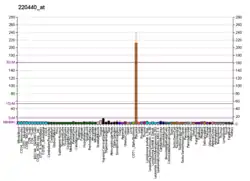| LGALS13 | |||||||||||||||||||||||||||||||||||||||||||||||||||
|---|---|---|---|---|---|---|---|---|---|---|---|---|---|---|---|---|---|---|---|---|---|---|---|---|---|---|---|---|---|---|---|---|---|---|---|---|---|---|---|---|---|---|---|---|---|---|---|---|---|---|---|
| |||||||||||||||||||||||||||||||||||||||||||||||||||
| Identifiers | |||||||||||||||||||||||||||||||||||||||||||||||||||
| Aliases | LGALS13, GAL13, PLAC8, PP13, galectin 13 | ||||||||||||||||||||||||||||||||||||||||||||||||||
| External IDs | OMIM: 608717 HomoloGene: 49329 GeneCards: LGALS13 | ||||||||||||||||||||||||||||||||||||||||||||||||||
| |||||||||||||||||||||||||||||||||||||||||||||||||||
| |||||||||||||||||||||||||||||||||||||||||||||||||||
| |||||||||||||||||||||||||||||||||||||||||||||||||||
| |||||||||||||||||||||||||||||||||||||||||||||||||||
| Wikidata | |||||||||||||||||||||||||||||||||||||||||||||||||||
| |||||||||||||||||||||||||||||||||||||||||||||||||||
Placental protein 13 (PP13) is a protein that in humans is encoded by the LGALS13 gene.[3][4]
Structure and function
Function
It is composed of two identical subunits which are held together by disulfide bonds. The monomer of this protein has structural similarity to several members of the beta-galactoside-binding S-type lectin family, but it could not bind beta-galactoside. This is because the ligand binding site is lack of key residue for binding beta-galactoside. [5]It is a galectin-like protein. The ligand of this protein is still unknown.
Clinical significance
PP13 levels that are low in the first trimester of pregnancy confers a higher risk for developing pre-eclampsia later in pregnancy.[6]
References
- 1 2 3 GRCh38: Ensembl release 89: ENSG00000105198 - Ensembl, May 2017
- ↑ "Human PubMed Reference:". National Center for Biotechnology Information, U.S. National Library of Medicine.
- ↑ Bohn H, Kraus W, Winckler W (Jul 1983). "Purification and characterization of two new soluble placental tissue proteins (PP13 and PP17)". Oncodevelopmental Biology and Medicine. 4 (5): 343–50. PMID 6856484.
- ↑ Than NG, Sumegi B, Than GN, Berente Z, Bohn H (November 1999). "Isolation and sequence analysis of a cDNA encoding human placental tissue protein 13 (PP13), a new lysophospholipase, homologue of human eosinophil Charcot-Leyden Crystal protein". Placenta. 20 (8): 703–10. doi:10.1053/plac.1999.0436. PMID 10527825.
- ↑ Su J, Wang Y, Si Y, Gao J, Song C, Cui L, Wu R, Tai G, Zhou Y (January 2018). "Galectin-13, a different prototype galectin, does not bind β-galacto-sides and forms dimers via intermolecular disulfide bridges between Cys-136 and Cys-138". Scientific Reports. 8 (1): 980. Bibcode:2018NatSR...8..980S. doi:10.1038/s41598-018-19465-0. PMC 5772480. PMID 29343868.
- ↑ Huppertz B, Meiri H, Gizurarson S, Osol G, Sammar M (February 2013). "Placental protein 13 (PP13): a new biological target shifting individualized risk assessment to personalized drug design combating pre-eclampsia". Human Reproduction Update. 19 (4): 391–405. doi:10.1093/humupd/dmt003. PMID 23420029.
External links
This article is issued from Wikipedia. The text is licensed under Creative Commons - Attribution - Sharealike. Additional terms may apply for the media files.


